No-one wants to take us to Hauz Khas. The auto drivers here each have a well paying, easy business driving passengers between Qubt Minar and the station, where they can pick up a return fare. Finally, after we trudge to the main road, drooping, an auto driver stops for us. Now we can see why so many refused – the traffic is horrible on this section. Thick, loud, fume ridden, in the hottest part of the day. We stop at some lights and a girl no more than three years old comes to sell us a pen. I fumble to find money, and the traffic growls and beeps to move on – the coin falls in the gutter. The auto driver mops his face with a piece of rag kept on the side. His feet are weathered and filthy in their broken plastic sandals. When he drops us off near a park entrance in Hauz Khas, we give him a good tip – and he is so pleased, unlike drivers on the tourist circuit, who sulk, demanding ever more. I imagine a good bit of money changes hands to have the lucrative routes.
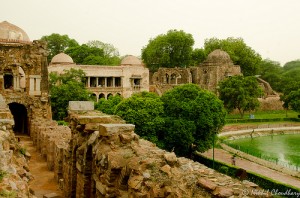 Hauz Khas is known for being an upper-middle-class enclave that was once a dairying village, but now has words like “quirky” “arty” and “boutique” in its descriptions. That should have been warning enough, but it is also enticingly set amongst wooded parks and the ruins of an early 14th Century tank, a lake-like reservoir, built as the water supply for Delhi’s long ago “second city”, Siri. A seminary, a mosque and many tombs are scattered around this verdant oasis, alongside newish apartment buildings and the above-mentioned trendy small shops. One newspaper description is that “Delhi’s urban villages are where the sylvan past meets the present boho-chic.” I was hoping to find this purportedly romantic combination, and also the shop selling old film posters (perhaps Dilip Kumar’s dreamy eyes in “Mughal-e-Azam”, or the raunchy Fearless Nadia, a sort of female Bollywood Zorro!)
Hauz Khas is known for being an upper-middle-class enclave that was once a dairying village, but now has words like “quirky” “arty” and “boutique” in its descriptions. That should have been warning enough, but it is also enticingly set amongst wooded parks and the ruins of an early 14th Century tank, a lake-like reservoir, built as the water supply for Delhi’s long ago “second city”, Siri. A seminary, a mosque and many tombs are scattered around this verdant oasis, alongside newish apartment buildings and the above-mentioned trendy small shops. One newspaper description is that “Delhi’s urban villages are where the sylvan past meets the present boho-chic.” I was hoping to find this purportedly romantic combination, and also the shop selling old film posters (perhaps Dilip Kumar’s dreamy eyes in “Mughal-e-Azam”, or the raunchy Fearless Nadia, a sort of female Bollywood Zorro!)
Perhaps it was because we feel exhausted 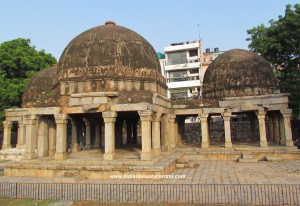 when we arrive, but we cannot get a grip on Hauz Khas Village. The remains of Siri are beautiful, the Sultans’ tombs, seminary and mosque are so atmospheric, but we have had too much today of architectural antiquity. It needs a qualified eye, and more time spent, to appreciate more fully the detail, the era. Students laze and laugh, sitting on the stone walls. It’s all a part of the backyard, for them!
when we arrive, but we cannot get a grip on Hauz Khas Village. The remains of Siri are beautiful, the Sultans’ tombs, seminary and mosque are so atmospheric, but we have had too much today of architectural antiquity. It needs a qualified eye, and more time spent, to appreciate more fully the detail, the era. Students laze and laugh, sitting on the stone walls. It’s all a part of the backyard, for them!
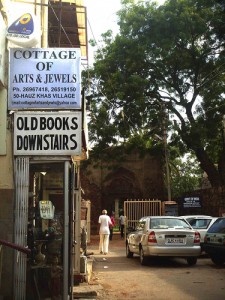 The little restaurants and bars are very expensive, serving pizzas or other western food we do not want; many were recently closed down, temporarily, because they do not meet water quality runoff standards (it was in the news for days). The boutique shops we pass also stock expensive looking items of clothing or art, or craft, not to our taste. There seems to be no centre to the village; it meanders, and we find ourselves eating Chinese takeaway food in a laneway alongside a bunch of privileged teenagers, flirty, mobile phoned, trendily dressed, vacuous (but sweet, I am sure – they are just young, after all). Later, we drink the most expensive iced coffee we’ve had on our travels, in an air-conditioned restaurant, just so we can use the toilets there. Michael notices another group of older teens come in, and wonders where they find the money to meet up in such a salubrious space.
The little restaurants and bars are very expensive, serving pizzas or other western food we do not want; many were recently closed down, temporarily, because they do not meet water quality runoff standards (it was in the news for days). The boutique shops we pass also stock expensive looking items of clothing or art, or craft, not to our taste. There seems to be no centre to the village; it meanders, and we find ourselves eating Chinese takeaway food in a laneway alongside a bunch of privileged teenagers, flirty, mobile phoned, trendily dressed, vacuous (but sweet, I am sure – they are just young, after all). Later, we drink the most expensive iced coffee we’ve had on our travels, in an air-conditioned restaurant, just so we can use the toilets there. Michael notices another group of older teens come in, and wonders where they find the money to meet up in such a salubrious space.
The new middle class of India make me nervous. It feels as if they have lost grounding in the old culture and the new is still being formed. That has benefits, of course; we must evolve and adapt. This is a particularly complex issue for India with its ages-old cultural mores, one that is much discussed in social history forums. For foundations, or social philosophies, do matter.
The new wealthy (as is the case in any nation) seem to get by on confidence, pride and material show, which can seem uncaring, egotistical and snobbish. Culture becomes, perhaps, a badge of status or nationality rather than a guiding light. These are harsh words, I know, but I’m not alone in sensing the danger, and the unpleasantness, of this. Other India watchers we speak to, or who write about these unstable times, may use different words, though in a similar vein. It is an enormously youthful population, but the older, parental generation in Hauz Khas (which I am using to exemplify this upper middle class, India-wide) have a rather arrogant air. Perhaps it is the same sense of superiority found worldwide among the wealthy – say, in Rose Bay, or Potts Point in Sydney, or Toorak in Melbourne. But daily the people of Hauz Khas must drive the pot holed roads crammed with poor working autorickshaw men and child pen sellers; here, poverty is still overwhelmingly obvious and the infrastructure, the garbage, the lack of proper sewerage, still an enormous impediment. The middle class do know this, though perhaps not with the clarity of outsiders (who, as a well known historian once said, may not have insider knowledge, but do have fresh eyes); the difficulty seems to be achieving change when institutions (such as all levels of government) are ‘mired in corruption”, as the cliché goes.
Yet in trendy Hauz Khas and elsewhere there are little shops selling products from recycled materials, and other signs of “green” initiatives, most of which are driven by this youthful generation, we are told. But the ‘youthful generation’ and their motorbikes …sigh… I will come back to this topic another time. We have seen the changes over many years, now.
We pass two of the old poster shops, but I am too tired now to trawl through them. Besides, I hear they charge five times the amount that the poster man at Darya Ganj Sunday Markets does. We’ll go there instead. I had been curious about this area, and now my curiosity is satisfied enough, though my depleted state leads me, perhaps, to be unfair to Hauz Khas. But I think I get the picture –if not the poster … we are simply not insiders enough to this privileged scene to understand its developments. Yet it slots in to a particular understanding I have garnered of that privileged world. I am satisfied by that, and not, after all, surprised. If my story here is unclear, seems speculative, incomplete, it is because that is what each place we visit is, for us: pieces of the jigsaw of India. A complex, “moveable feast” of a jigsaw.
We return to Old Delhi on the evening commuter train, watching the jeans clad legs and mobile phone hands of the line of young men opposite, one of whom falls asleep repeatedly on his neighbour’s shoulder. We push through the solid crowd at the doors to our station, tackle the walk along Chandni Chowk, and collapse with relief in our lovely room at Tara Palace.
Then as the light fades, we go to the rooftop, watching as the Red Fort walls deepen and glow in the sun’s reflection, the monkeys scamper on a ledge nearby. Beautiful singing fills the air from the Jain Temple; a beautiful azan, call to prayer, rises also from the Jama Masjid, Delhi’s huge mosque, very close by. The man who lives in a house below, comes home from work and plays ball with his German Shepherd, Tyson, (after the boxer – tough is good!), on his rooftop, and we exchange greetings. I love the hazy Delhi rooftop evenings.
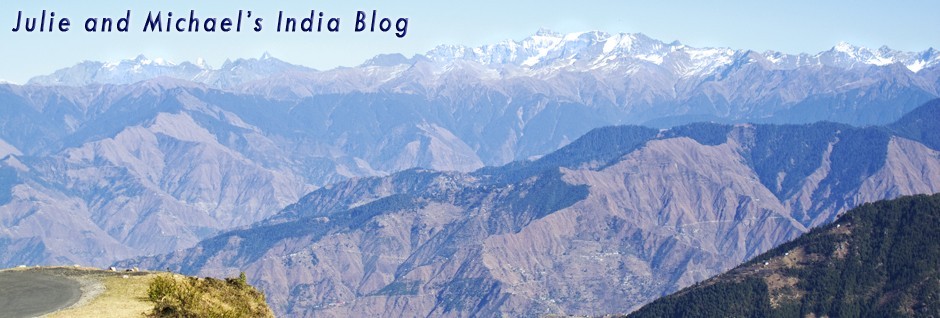
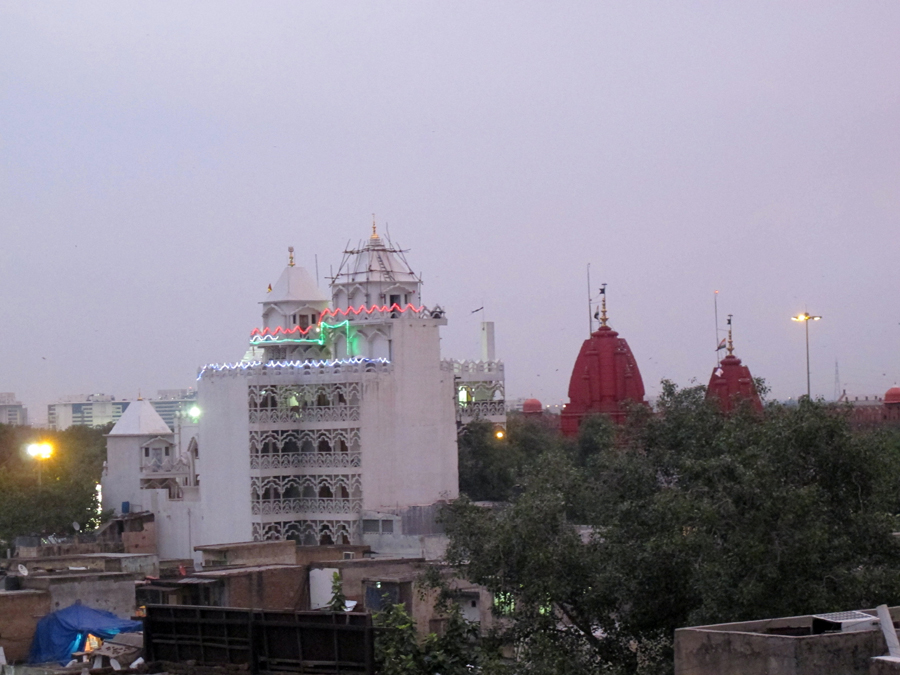
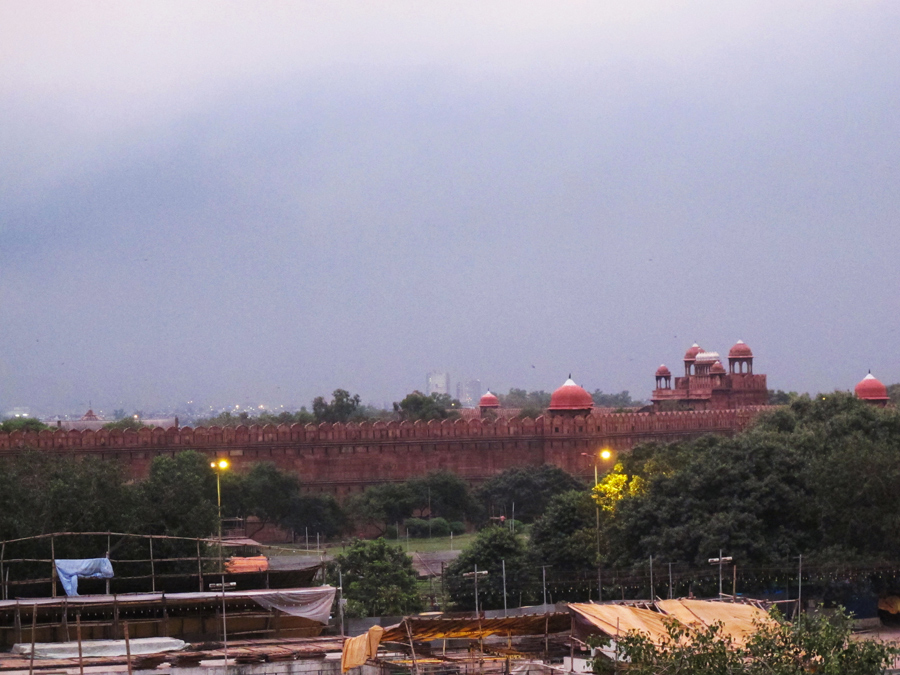
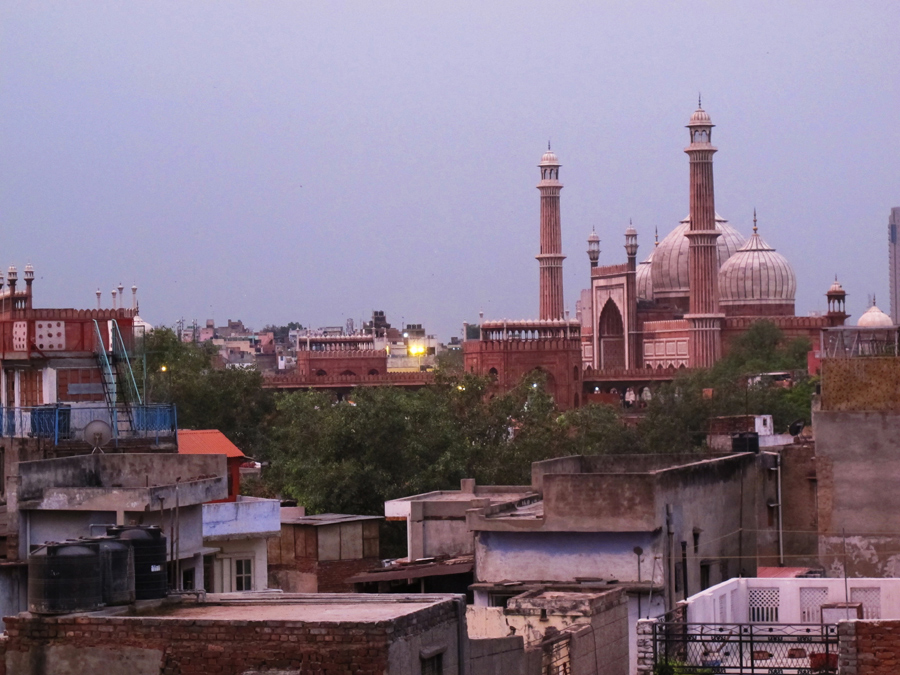
The first three photos, those of Haus Khas, are not ours, but taken from the web. We chose them because we saw those same views.
The story continues, the mystery deepens, the rich tapestry of India is woven in evocative narrative.
With the mass of people, how is it that especially within a city like Deli, such large open green spaces, gardens and occasional tranquility can still be found. Each of your entries have revealed stunning natural beauty, architecture, craftsmanship to rival Europe’s finest and magical places of solitude, all set amidst crushing populations, squalor and rapid urbanization. I also realize now just how unaware some can be (me) to the circumstances of those around them. I was oblivious to what must have been staggering poverty endured by those whose countries were mere curiosities and conveniences to me as I traveled there in my youth. Perhaps I took for granted their circumstances and assumed they took theirs for granted too, just as we may wistfully daydream of being millionaires but are otherwise content with our lot.
But that is part of the weave in the tapestry after all.
Just to say, I love your writing…Keep me enthralled.
Love, T
Thank you for writing in and with such perceptive comments. I’m so glad you enjoyed reading this -gives me heart to carry on! Though I enjoy writing it too, as a sort of recapitulation of each place. I just wish I’d catch up with the present..
It is a really good point you make about the green spaces in such a big city (population around 17 million!). I really noticed that, this time, because it was post monsoon, before the dust gathered again. But the green spaces are rapidly becoming urbanised -Hauz Khas is one of them. There seems to be efforts to look after the trees, in Delhi.One council was being prosecuted for putting cement too close around some old trees..a warning in the newspaper. And you’d love the craftsmanship, which you mention. You have the knowledge to appreciate it fully. Thousands of years of craft and art passed down. The next entry is going to be about the Crafts Museum,actually.
Travelling when very young, people can be too overcome by the newness of everything, and coping with it, to fully appreciate the conditions around them.That’s natural. A kind hearted person such as you are would be miserable to see the way many in the world have to live. It is one of the challenges of travel here,and makes me question so much, about the world and myself, every single time I come. It tears at the emotions and to some degree you have to switch off a bit to survive getting through the day! We can’t solve it single-handedly (though some amazing people do try), but sometimes even a smile helps, I think. India is so complex and there is much we can’t understand (nor can they I bet!). Yes, it’s a very rich tapestry indeed. xx
In my early 30s I first saw My Dinner With Andre, a movie directed by Louis Malle. I was so enthralled with it, that when I first met my partner, Carl, I immediately took him to see this movie, thinking it would deepen the strong connection between us. As I watched the movie for the 2nd time, I thought, “This isn’t the same movie. It’s a different conversation.”
Carl loved the movie, and since then, we have watched it every 5 years or so, and each time for both of us it is a different movie. It’s just a conversation between two old friends in a restaurant, but because we change, the conversation changes. We respond to different threads in the conversation, and certainly this demonstrates the power of the reader/audience in the creation of any work of art.
I suspect Delhi is much like My Dinner with Andre. It’s a complex conversation, and each time, Julie, you experience it, a different aspect becomes dominant.
Also, we see through our own lens. When I was in Cambodia, I got very sick. The rest of our group saw a beautiful Cambodia with gentle people and a rich culture. I saw people worn out, dirty, lethargic, and beaten. I could see they felt just like I did. When I learned later that over 2/3 of the population is affected by TB and that haemorrhagic dengue fever is rampant, as well as Aids and malaria, I realised that my lens was focused on this because of my own condition.
Of course, all of the above is true about Cambodia. It is all these things — beautiful, rich, sick, crippled. Had I been well, I would have seen a different country than the one I saw.
That’s an apt analogy Joan. Every time I watch that film I feel it’s a new film.
India is different every time, but I recall being sick one night in Varanasi when I had the feeling I was surrounded by a sea of old age, sickness and death, which was true of course. But once I was better, I felt surrounded by an exciting adventure.
We haven’t had too much illness this time, so the ubiquitous garbage is more a mild curiosity of why they can’t use rubbish bins. In fact I strangely enjoy it – not sure why, but it creates a carefree mood for me, except when my mind tells me of the consequences.
This trip is much more about relaxing for long times in beautiful places – previously we would only include one 2 – 2.5 weeks stay, where as now we have multiple 2 week stays which allows us to settle in.
I love any reminder of “My Dinner with Andre”, too, Joan!
Delhi itself is multi -layered (as is anywhere), of course, but somehow that is particularly said of India. And definitely my mood affects how I’m seeing things! The garbage wasn’t bothering me so much, as it is just a fact of life there -actually in Delhi I think they are dealing with it much better than in the past. It’s just different to Australia, where you don’t have a major garbage dump on a street.
My view of Hauz Khas was probably influenced by my exhaustion, true – yet it’s the “new” India that bothers me a little…brash, somehow… opinionated, aren’t I!